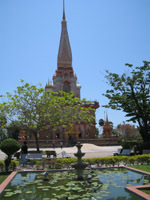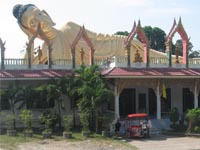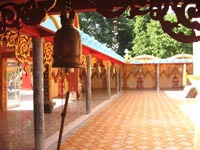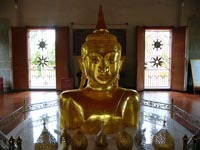Phuket's Temples
'Wat' is the Thai word for temple. There are many wats in Phuket and foreign visitors are always welcome.
 95%
of Thais are Buddhist and most of them have great respect for their religion.
It is common for Thais to visit their local temple for special occasions or
just to make merit. Thai Buddhist temples are very striking with their bright
gold and red colours and ornate spires. Inside you will find Buddha images
and other artifacts.
95%
of Thais are Buddhist and most of them have great respect for their religion.
It is common for Thais to visit their local temple for special occasions or
just to make merit. Thai Buddhist temples are very striking with their bright
gold and red colours and ornate spires. Inside you will find Buddha images
and other artifacts.
In Phuket, around a quarter of the population is Muslim and there are as many mosques as temples. Muslims may have been getting a bad press recently but the Muslims in Phuket are a friendly bunch. Most mosques in Phuket will welcome foreign visitors but you should ask permission to enter first and not go if any ceremony is taking place. You must dress modestly, especially women.
Temple Etiquette
When you visit a temple, you should dress modestly. You should wear trousers or knee length shorts/skirts. You should wear a sleeved shirt. T-shirts are fine but not a singlet.
Before entering religious buildings, you should remove shoes, hats and sunglasses.
The soles of the feet are considered to be physically and spiritually the lowest part of the body. If you sit in front of any religious objects such as a Buddha image, you must not point the soles of your feet towards the object. Bend your legs so your feet point away.
What Happens at the Temples?
Thais visit temples to make merit. They will usually begin with a visit to the temple shop where they will buy a set of offerings for Buddha. This will normally consist of flowers, candles, josh sticks and gold foil. It is a way of donating to the temple.
Then they take their offerings to the temple. They will place the flowers, light the candles, stick them to a rack, light the josh sticks and place them in tubs full of ash. Then they will pray to Buddha before sticking the gold foil to the images of Buddha or other revered religious figures.
You may see Thai visitors performing other odd-looking rituals:
- You may see people closing their eyes and throwing two wooden blocks to the floor. They are asking a question. If the two blocks land with the same side up the answer is no, if they land different sides up, the answer is yes.
- You may see people rattling a cup full of sticks at an angle until they slowly extract a single stick. These sticks have numbers etched on them. They will collect a fortune prediction for their number from boxes at the side of the temple.
- You will often see lottery tickets for sale outside temples. Thais are great ones for lucky numbers and fate. After making merit they will often want to buy a lottery ticket that contains their lucky number.
You can feel free to join in with the religious rituals. As long as you do it in a respectful manner, the locals will be happy to see you joining in and will point you in the right direction.
Wat Chalong
 Chalong
Temple is the most popular and famous temple on the island. It is on Chao
Fa West road approx three kilometers from Chalong Circle. The temple's rich
and colourful history make it the most highly regarded in Phuket. Since it
was built in the late 18th century, it has played a central role in many of
the events that have shaped Phuket's history.
Chalong
Temple is the most popular and famous temple on the island. It is on Chao
Fa West road approx three kilometers from Chalong Circle. The temple's rich
and colourful history make it the most highly regarded in Phuket. Since it
was built in the late 18th century, it has played a central role in many of
the events that have shaped Phuket's history.
The main temple contains images of some of the revered monks that have played important roles in the temple's history. Many Thais come here to pay respect to Buddha and make merit. You can see them lighting candles, offering flowers and sticking gold foil to the images of Buddha and revered monks.
The most sacred artifact at Wat Chalong is the Phra Borom Sareerikatat relic, claimed to be a piece of Lord Buddha's bones. It is in a Chedi at the top of a three-storey 60-meter high pagoda that also contains three floors of Buddha images and other religious figures.
Wat Sri Soonton (Wat Sri Sunthon)
 Thepkrasattri
Road is the main route from Phuket Town to the north of the island. It goes
passed the airport and on to the mainland. A drive along this road allows
a temple tour of three of the most interesting temples in Phuket.
Thepkrasattri
Road is the main route from Phuket Town to the north of the island. It goes
passed the airport and on to the mainland. A drive along this road allows
a temple tour of three of the most interesting temples in Phuket.
If you are driving north, the first is Wat Sri Soonton. It is just over a kilometer north of Heroines monument. The two heroines are sisters who led the successful resistance against Burmese invaders in 1785. The monument is a statue of the two sisters in the center of a traffic circle.
The temple is named after one of the two heroines, Thao Sri Sunthon. This temple is usually a quiet spot with just a few locals paying respect to Buddha. It is home to the largest reclining Buddha image in Phuket. You can go up the stairs at the back of the building to get a close view.
Wat Phra Nang Sang
 The
second fascinating temple on Thepkrasattri Road
is Wat Phra Nang Sang in Thalang, just south of the Thalang
intersection traffic lights. It is more than 500 years old, which makes it
the oldest temple in Phuket and it just oozes atmosphere.
The
second fascinating temple on Thepkrasattri Road
is Wat Phra Nang Sang in Thalang, just south of the Thalang
intersection traffic lights. It is more than 500 years old, which makes it
the oldest temple in Phuket and it just oozes atmosphere.
This was an important location during the 1785 Burmese invasion. The two heroines used it to rally supporters to resist the Burmese invaders. You can just picture the two sisters rousing the locals to fight.
The temple's name, Phra Nang Sang, means built by a royal lady. The legend goes that Lady Luad Khao was sentenced to death for having an affair. Before her death, she asked for permission to pay her last respects to the Buddha relics in Sri Lanka. When she returned, she built this temple before her execution. When she was executed, her blood ran white showing her innocence and earning her the name Luad Khao (white blood).
The temple is in a large court yard. There are Buddha images and a statue of the two sisters. There is also a remarkable 50 year old mummy of a former monk of the temple. The remarkable thing is the mummification process was not carried out after his death. He self-mummified by starving himself and consuming a mysterious concoction of embalming fluids.
Wat Phra Thong
 The
third and final stop on our temple tour along Thepkrasattri Road is Wat Phra
Thong. The name means Golden Buddha Image Temple.
The
third and final stop on our temple tour along Thepkrasattri Road is Wat Phra
Thong. The name means Golden Buddha Image Temple.
The most notable artifact here is the Golden Buddha statue that emerges from the ground inside the main temple. This Buddha image has a long and colourful history.
The simple story says that when the Burmese invaded in 1785 they tried to dig the Buddha image out of the ground but it would not budge. After the Burmese were driven out, the locals were so impressed with the images resilience that they covered the Buddha in gold and it has remained intact ever since.
There is a longer and even more colourful version of the story although it may contain a degree of legend. In this story the Buddha image emerged from the ground in a field. A boy took his buffalo to pasture in the field and tied it to the image, not knowing what it was. The boy and the buffalo both died. The villagers then tried to dig up the image but they were attacked by a swarm of hornets. Many years later when the Burmese invaded, their soldiers tried to dig up the image. They were attacked and bitten by ants and hundreds of the soldiers fell sick and died. When the Burmese were driven out the locals decided to build a temple around the image.
The temple also has a nice museum with lots of old religious artifacts and also many fascinating items of life from Phuket's olden days.
You will see the signposts to the temple just a little north of the Thalang intersection. If you are travelling north you need to throw a u-turn and then turn left.
Chinese Temples, Phuket Town
There are several ornate Chinese temples or shrines in Phuket Town. These are Taoist and are dedicated to particular gods. They are the centre of activities during the vegetarian festival when they become a scene of total mayhem. Of particular interest are the Put Jor and Jui Tui shrines on Ranong Road at the junction with Soi Phuthon. There is also the Shrine of the Serene Light tucked away off Phang Nga Road. Another is the Sam San shrine on Krabi Road near the junction with Patiphat Road.
See Phuket Town: Temples for more information.
